How to Identify Your Crystals Effectively

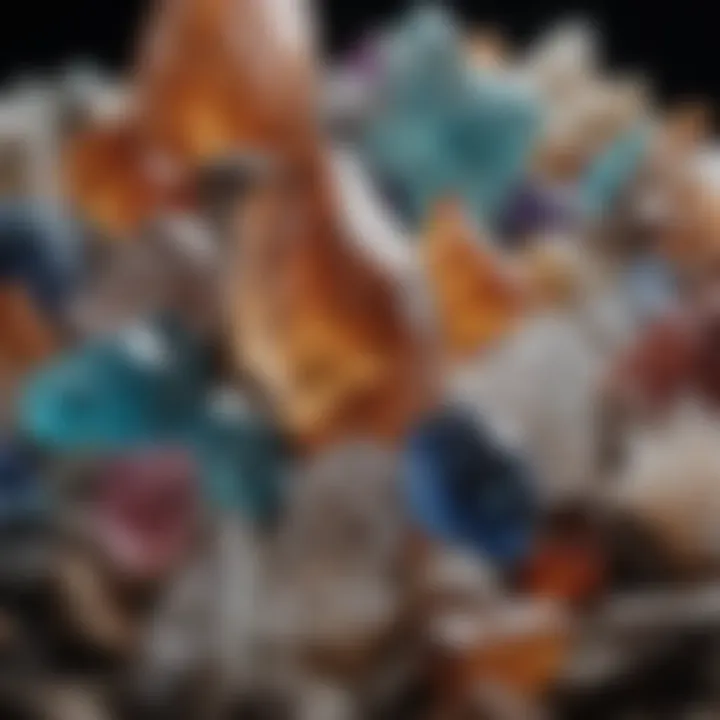
Intro
Crystal identification is not merely a hobby; it is an intriguing blend of science, art, and personal connection. Many people are drawn to crystals for their beauty, energy, and historical significance. Whether you are a novice collector or a seasoned enthusiast, knowing how to identify your crystals can deepen your appreciation and understanding of these natural wonders.
In this guide, we will explore various methods and techniques for crystal identification. From identifying essential characteristics to visual inspections, we will provide you with clear and practical information. Additionally, we will highlight resources available for those who wish to expand their knowledge.
This article aims to empower you, whether you are starting your collection or looking to refine your expertise.
Featured Collectible of the Month
Overview
This section spotlights a specific crystal that stands out for its unique properties and appeal. For this month, the featured crystal is Amethyst. Known for its striking violet color, Amethyst has enchanted collectors for centuries. It is often associated with healing and tranquility and can be found in many beautiful shapes, from clusters to polished points.
Historical Significance
Amethyst has a rich history, dating back to ancient civilizations. The Greeks valued the stone for its beauty and believed it had the power to prevent intoxication. The name "Amethyst" is derived from the Greek word 'amethystos', which means "not intoxicated." In addition, Amethyst has been favored by various cultures, from ancient Egypt to the royal families of Europe, who regarded it as a symbol of power and protection.
Identification Techniques
Identifying a crystal requires careful observation and the use of specific techniques. Below are some key methods to consider:
Visual Characteristics
When looking at a crystal, pay attention to the following visual features:
- Color: The first element to observe; colors can range from clear to deep hues.
- Transparency: Observe if the crystal is transparent, translucent, or opaque.
- Luster: This refers to how light reflects off the surface. Crystals may have a glassy, pearly, or dull finish.
- Shape: Familiarize yourself with common shapes like points, clusters, and geodes.
- Surface Features: Look for markings, inclusions, or growth patterns that are unique to each type.
Resources for Identification
To aid your crystal identification journey, the following resources can be invaluable:
- Books: Look for guides like The Crystal Bible by Judy Hall or Healing Crystals for Beginners by Karen Frazier.
- Websites: Online databases, such as Wikipedia, offer comprehensive details on different varieties of crystals.
- Forums: Engage with other collectors on platforms like Reddit to share experiences and gather insights.
- Social Media: Joining groups on Facebook related to crystal collecting can provide community support and knowledge.
"Understanding the unique properties of each crystal not only enhances your collection but also enriches your journey into the world of geology and mineralogy."
This overview of effective identification techniques combined with the insights on our featured crystal can sharpen your skills and encourage a deeper appreciation for crystal collecting.
Understanding Crystals
Understanding crystals is essential for anyone interested in crystal identification. Crystals are not just decorative items; they possess unique properties and can offer insights into natural phenomena. By recognizing different types of crystals, enthusiasts can appreciate their beauty and intrinsic value.
This section delves into key elements that define what crystals are and the diverse classifications available. Knowing these classifications streamlines the identification process and enhances the understanding of collecting habits. Whether you are a novice or a seasoned collector, grasping the foundational definitions and types can significantly enrich your experience.
Definition of Crystals
Crystals are solid materials whose constituents, such as atoms or molecules, are arranged in an orderly repeating pattern. This regularity gives rise to their often striking symmetry and shape. They can be found naturally in the environment or created synthetically. The structure of a crystal can significantly influence its physical properties, including hardness, luster, and the way it interacts with light.
Crystals play a critical role in our understanding of material science and geology. Their study leads to insights into formation processes and environmental conditions required for their development. Identifying a crystal helps in understanding these properties, which can be beneficial for practical applications in various fields like electronics and optics.
Types of Crystals
Crystals can be categorized in multiple ways, but two primary lenses for classification are: natural vs. synthetic and mineral vs. organic. Each category has unique characteristics and implications for crystal enthusiasts.
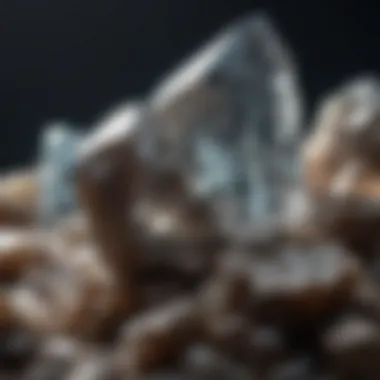
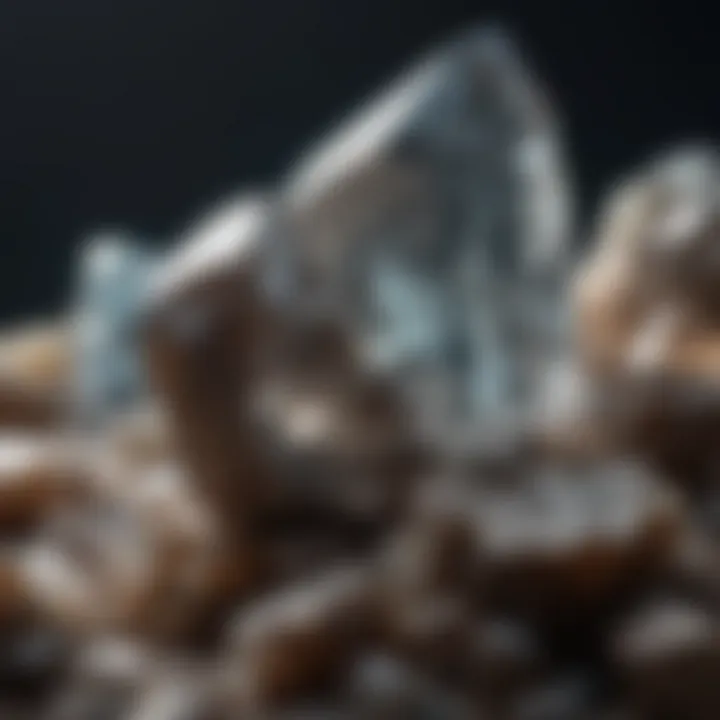
Natural vs. Synthetic Crystals
Natural crystals form through geological processes over long periods, while synthetic crystals are manufactured in laboratories. One key characteristic of natural crystals is their authenticity. They typically carry a story from their origin that synthetic counterparts cannot replicate.
Natural crystals often have unique variations in color and pattern due to environmental factors during their formation. These variations contribute to their appeal among collectors. Synthetic crystals, on the other hand, offer consistency in quality and are often less expensive. However, they may lack the depth of character that natural ones possess. Understanding this distinction can help collectors make informed choices about their acquisitions, depending on personal preferences and budget considerations.
Mineral vs. Organic Crystals
The distinction between mineral and organic crystals lies in their composition and origin. Mineral crystals are inorganic materials with a defined chemical composition and structure. For example, quartz and calcite are mineral crystals that are abundant and varied.
In contrast, organic crystals, such as those formed from biological processes, include materials like pearls and amber. The key characteristic of mineral crystals is their consistency in structure and predictable properties, which makes them popular for scientific and aesthetic purposes. Organic crystals, while less predictable, can offer a unique charm and connection to the natural world. Collectors may favor one type over the other depending on their interest in geology versus biological contexts.
Important Characteristics for Identification
Identifying crystals accurately requires an understanding of their important characteristics. This section emphasizes key elements such as hardness, color, clarity, and luster. Recognizing these traits aids in categorizing crystals and enhances the overall identification process. Accurate identification leads to a deeper appreciation of crystals, whether for collectors or enthusiasts.
Hardness
Mohs Hardness Scale
The Mohs Hardness Scale is a widely used tool for determining the relative hardness of minerals. It lists ten minerals in order of increasing hardness, from talc, which is the softest, to diamond, the hardest. Each mineral can scratch the ones below it on the scale. This reference is beneficial as it provides a simple framework for assessing crystal durability. Its unique feature lies in its universal applicability across various crystal types, from quartz to emerald. However, it only offers relative hardness rather than precise measures.
Testing Methods
Testing Methods assess a crystal's hardness through practical engagement. Common techniques include scratching the crystal against a material of known hardness or using a specialized tool. This hands-on approach makes it easy for enthusiasts to learn. The key characteristic of these methods is their accessibility, as many beginner identification kits incorporate simple tools. While effective, they may sometimes not yield definitive results due to the presence of complex variables like surface finishes or coatings.
Color and Clarity
Color Variations
Color variations in crystals provide essential clues for identification. Each mineral may exhibit a broad spectrum of colors owing to specific chemical compositions. For instance, amethyst is typically purple, while citrine is yellow. This characteristic is particularly useful in distinguishing between similar minerals. However, minerals with impurities can exhibit unexpected colors. While beneficial, relying solely on color may lead to misidentification if other factors are not considered.
Impurities and Inclusions
Impurities and inclusions are crucial for identifying specific types of crystals. These features can affect color and clarity, providing unique identifiers. For example, rutile inclusions in quartz can indicate that the crystal is variegated. Understanding these imperfections helps to understand the crystal’s origin and nature. However, the presence of multiple impurity types can complicate identification, requiring careful observation.
Luster
Types of Luster
Luster refers to how light interacts with a crystal's surface, influencing its appearance. The main types include metallic, glassy, pearly, and dull. Identifying these can contribute to distinguishing between minerals that may seem alike. Its core benefit lies in the visual aspect, giving enthusiasts immediate clues about crystal classification. Despite its importance, relying solely on luster can be misleading if the crystal has been polished or treated.
Visual Inspection Techniques
Visual Inspection Techniques are essential for evaluating luster and other characteristics. Techniques include examining the crystal under natural light, using magnifying tools, and checking the surface texture. These methods allow for a comprehensive view of the crystal. The key feature is that they provide quick insights without requiring intricate equipment. However, results can be subjective and may vary depending on the observer's experience or the ambient conditions.
Visual Inspection Techniques
Visual inspection techniques are critical in the process of crystal identification. They serve as the primary method for enthusiasts and collectors to scrutinize their specimens closely. This process helps to discern distinct characteristics that define each crystal type, leading to more accurate identification. By focusing on specific elements like weight, size, surface texture, and the use of tools, one can gain greater insights into the nature of their crystals. Understanding visual inspection aids in building a solid foundation for further exploration in the fascinating world of crystals.
Physical Examination
Physical examination relies heavily on the physical properties of crystals, such as weight and size considerations.
Weight and Size Considerations
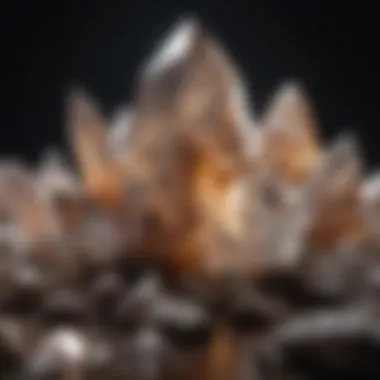
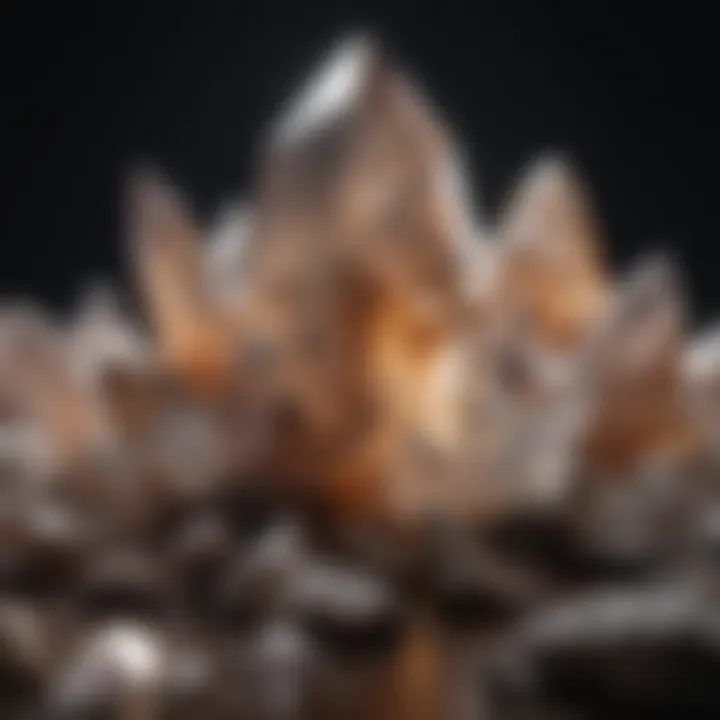
Weight and size are significant when it comes to identifying crystals. Each type of crystal tends to exhibit a particular weight relative to its size, which can provide clues about its composition. For example, a specimen that feels heavier than expected for its size may indicate a denser mineral, such as hematite. This is a beneficial and popular aspect for anyone engaged in crystal identification because it allows for immediate, tactile feedback regarding the specimen.
The unique feature of weight and size considerations lies in their ability to guide initial assessments without sophisticated tools. However, it should be noted that some crystals may have similar weights, and size alone does not always provide a definitive identification. Thus, physical characteristics may necessitate further examination alongside other features.
Surface Textures
Surface textures also play a crucial role in crystal identification. The textures can range from smooth to rough, and each texture type can point to different crystal formations. For instance, a rough and pitted surface may indicate a mineral like quartz, while a smooth and glassy texture might suggest a polished gemstone.
The key characteristic of surface textures is that they can often indicate the environment in which the crystal formed. This aspect is beneficial for both beginners and experienced collectors, as it provides a visual cue that is often easy to recognize.
In terms of uniqueness, surface textures are diverse and can reveal much about a crystal’s history. However, one disadvantage might be that certain surface properties can be altered through polishing or weathering, potentially misleading identification.
Use of Tools
Utilizing tools during the identification process can significantly enhance accuracy. Tools like magnifying glasses and refractometers allow for deeper analysis of a crystal’s properties.
Magnifying Glass
A magnifying glass offers the ability to closely examine crystals at a microscopic level. This tool highlights essential features such as inclusions, which are foreign materials trapped within the crystal. It is a beneficial choice for anyone exploring crystal identification as it provides clarity on details that are often invisible to the naked eye.
The unique feature of a magnifying glass is its portability and ease of use. Collectors can use it anywhere without needing extensive training. The disadvantage lies in the limitation of its magnification range, which might not be adequate for certain crystal types that require advanced analysis.
Refractometers
Refractometers measure the refractive index of crystals, contributing to identification by comparing it with standard values for various mineral types. This device is essential for discerning between similar-looking candidates, making it a powerful ally for serious collectors.
The key characteristic of refractometers is their precision. This makes them a popular choice among professionals and advanced hobbyists. Additionally, they can provide quick results that streamline the identification process. However, they can be costly and may require some learning to operate effectively.
Index of Reflection
The index of reflection provides a quantifiable measure that can aid in identifying crystals based on how they refract light. This is a more advanced technique but can yield precise information about a crystal’s identity when combined with other visual inspection techniques. Understanding the concept of refractive indices is crucial for differentiating between crystals with similar external appearances but different internal structures.
In summary, visual inspection techniques are vital for crystal identification. They empower collectors by providing immediate information and guiding further exploration into the attributes of their specimens.
Consulting Reference Materials
Consulting reference materials plays a vital role in the accurate identification of crystals. These resources provide structured information that can help differentiate between various types of crystals. They establish a framework that allows collectors to understand their specimens better and enhance their identification skills. Moreover, references offer insights into the properties, formations, and classifications of crystals, reinforcing the knowledge gained through direct examination.
Accessing quality reference materials can save time and reduce errors. Various books, online platforms, and discussions about crystals serve as reliable guides. Each format offers unique advantages in terms of accessibility and depth of information. For enthusiasts, leveraging these resources is a methodical way to build their expertise.
Books and Guides
Books and guides specifically focused on crystals are essential tools for identification. Well-researched texts often compile extensive databases and illustrations, which aid in recognizing characteristics. Buying a comprehensive book on mineralogy could be a worthwhile investment. Such resources often contain high-quality images and detailed descriptions that clarify features like crystal structure, hardness, and color variations.
Additionally, books provide historical context and information about the geographical locations where certain crystals can be found. This background knowledge gives a richer understanding and appreciation of the crystals collected.
Online Databases
Online databases represent a modern approach to crystal identification. The digital format allows for quick searches and instant access to a vast repository of information.
Crystal Identification Websites
Crystal identification websites like Mindat.org offer extensive databases for collectors. They allow users to search for specific crystals via names, properties, or images. This feature is profoundly beneficial as it enables users to cross-reference their findings with established data. The key characteristic of such websites is the interactive community aspect. Users can upload their own images and descriptions, thus enriching the database continuously.
One unique feature of these websites is the user-driven content. While it can lead to invaluable insights, it may also introduce inaccuracies. Therefore, users should verify the information from multiple sources before arriving at conclusions.
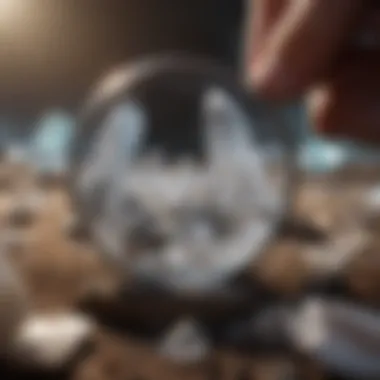

Forums and Discussion Boards
Forums and discussion boards provide a platform for enthusiasts to engage with one another. Websites like Reddit and Facebook host groups where members share experiences, photos, and useful tips related to crystal identification. This aspect of community interaction can be incredibly beneficial. Collectors can ask questions and receive answers from those with more experience.
The key characteristic of these platforms is their collaborative nature. Individuals gather to share knowledge, which can lead to rapid learning and broader perspectives. However, information may vary in accuracy, making it essential for users to critically assess advice before acting on it. A balance of input from trusted sources is necessary to ensure the reliability of the information shared.
Professional Assistance
Identifying crystals can be a complex task, especially for those who are new to the field or have limited experience. Seeking professional assistance can enhance the process significantly. Professionals, such as gemologists and local rock and mineral societies, offer specialized knowledge and tools that can lead to more accurate identifications. Engaging with these experts typically results in a more informed understanding of your crystals, potentially increasing their value and your overall enjoyment of the hobby.
Gemologists
Services Provided
Gemologists possess extensive education and training in the field of mineralogy. They offer a range of services that include laboratory testing, gemstone appraisals, and scientific analysis. Such services are pivotal for those wishing to confirm the authenticity of a crystal or to understand its characteristics fully. The key advantage of consulting a gemologist is access to advanced technology that the average collector may not have. Techniques such as spectroscopy and identifying inclusions cannot be effectively replicated at home.
However, potential downsides include costs associated with these services, which can be significant, depending on the complexity of the tests requested and the expertise of the professional. Depending on the location and popularity of the gemologist, waiting times for appointments may also be a factor to consider.
Selecting a Professional
Choosing the right gemologist is crucial for ensuring you receive quality service. Key characteristics to look for include credentials, experience, and reviews from past clients. A professional with a good track record will help you feel confident in their ability to assist you properly. Many gemologists offer different specializations as well, such as colored stones, diamonds, or antique stones. This specialization can add an extra layer of insight into your collection.
When selecting a professional, one main consideration is access. Some gemologists may only work on a commission basis, while others operate in a retail setting that allows for walk-in consultations. Understanding the fee structures, the tools they use, and their communication style can also influence your choice. It is beneficial to meet with a professional before making a commitment to discuss your needs and understand how they can assist you.
Local Rock and Mineral Societies
Local rock and mineral societies provide excellent benefits for crystal enthusiasts. These organizations often host workshops, field trips, and exhibitions, creating opportunities to learn from experienced collectors and professionals. Joining such a society could lead to valuable networks and friendships. Moreover, they often hold educational sessions focused on crystal identification, which can be beneficial for those eager to enhance their understanding.
Participating in these societies also offers practical experience, enabling members to practice identification techniques in a group setting. Members can share their discoveries and strategies, enhancing the collective knowledge base and making the hobby a communal experience.
Practical Tips for Enthusiasts
Understanding how to identify crystals can sometimes feel overwhelming due to the complexity and variety involved. However, adopting practical tips can significantly enhance the crystal identification process. Engaging with crystals requires both knowledge and experience, so practical advice can elevate your skills. These tips emphasize systematic approaches and provide frameworks that lead to successful identification. By implementing these strategies, you can enrich your understanding and appreciation of crystals.
Keeping a Journal
Documenting Findings
Keeping a journal to document your findings is critical for any crystal enthusiast. This practice helps you maintain a detailed record of each crystal you examine. Not only does this serve as a personal reference, but it also improves your ability to recall specific details about different types of crystals. One key characteristic of documenting findings is systematic organization. By noting down information such as color, size, location, and any tests performed, you create a comprehensive source of data. This choice is beneficial because it provides a clearer picture of your growing collection and enhances your learning curve.
The unique feature of documenting findings is that it encourages reflection on your experiences. You may discover patterns or identify similar traits in different crystals. The main advantage of this approach is that it solidifies your learning and contributes to a deeper connection with your collection. One disadvantage could be the time commitment necessary for consistent entries, but the rewards typically outweigh this drawback.
Tracking Progress
Tracking progress is another crucial aspect that can help you gauge your development in crystal identification. By recording your successes and challenges, you monitor your learning journey effectively. The key characteristic of tracking progress is that it instills a sense of accomplishment. As you reflect on your growth, it can motivate you to continue exploring and learning.
A unique feature of this method is its ability to highlight areas requiring further study. For example, if you note difficulty in identifying certain crystals, you can focus your efforts on that particular group. The main advantage of tracking progress is that it fosters continuous improvement and encourages goal setting. On the downside, it may require discipline to maintain regular updates, yet the insights gained are normally worth the effort.
Participating in Community Events
Workshops
Participating in workshops can significantly enhance your skills and knowledge. These events often provide hands-on experience and access to expert guidance. One key characteristic of workshops is the interactive learning environment. This can facilitate real-time feedback and allow you to ask specific questions relevant to your crystal identification needs. Such interactions can make workshops a popular choice among enthusiasts.
The unique feature of workshops is the collaborative atmosphere. You can share experiences with fellow enthusiasts and learn from their insights. The advantage of workshops lies in their immersive nature, allowing attendees to practice techniques under supervision. A potential downside could be the cost or limited availability of sessions, but the practical experience gained is invaluable.
Exhibitions
Exhibitions serve as excellent venues for crystal enthusiasts to explore a wide array of specimens. These events typically showcase various crystals from different cultures and geographical backgrounds. One key characteristic of exhibitions is the opportunity to view crystals that may not be locally available. This introductory exposure to diverse forms can greatly enrich your understanding of what exists in the crystal world.
The unique feature of exhibitions lies in the potential to network with other collectors and professionals. Engaging with exhibitors can lead to valuable insights and possible mentorship opportunities. The primary advantage is that exhibitions create an engaging atmosphere where learning can occur naturally. However, possible disadvantages include potential overwhelming sensory experiences due to the sheer volume of displays, which can detract from focused learning.



